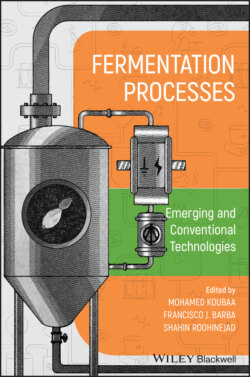Читать книгу Fermentation Processes: Emerging and Conventional Technologies - Группа авторов - Страница 22
1.2.3 Anaerobic Respiration
ОглавлениеSome microbial species use anaerobic respiration to obtain their energy in the absence of O2. During this process, the electrons that are removed from organic nutrients such as glucose follow the same pathways as in aerobic respiration, except that the final acceptor is not O2, but another inorganic molecule (e.g. sulfate, nitrate, etc.). The sulfate ion is generally reduced to hydrogen sulfide, while nitrate ion can be reduced to nitrite, nitrogen oxide, or molecular nitrogen. Some bacteria reduce carbonate to methane. The number of ATP molecules produced by anaerobic respiration varies from one organism to another and from one metabolic pathway to another. This number is generally less than the 38 mol of ATP generated by aerobic respiration, the energy yield is lower, and anaerobic microorganisms usually grow slower than aerobic ones.
